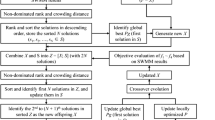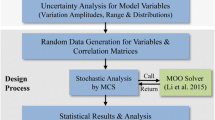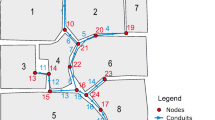Abstract
Under the influences of climate change and rapid urbanization, extreme rainfall events become more and more intensive and the urban flooding issues have been frequently faced in many cities in the world. Previous practical and scientific experiences have demonstrated that appropriate utilization of detention facilities and low impact development (LID) devices for urban region design could be important and effective ways to the flooding control and drainage service management of an urban stormwater drainage system (USDS). This paper investigates the optimal design and application of detention tank network and LID devices for achieving these multiple objectives in the USDS. The framework and method of LID-based multi-objective optimal design of detention tanks in USDS is first developed in this study, and a practical case in SA city of China is then taken for the application. The results of this study confirm the feasibility and validity of the proposed methodological framework for the LID-based multi-objective optimal design of detention tanks in the USDS. Specifically, both total investment costs and flooding risk have been greatly reduced by the optimal implementation of the detention tank and LID measures. Meanwhile, the results indicate that the LID devices may have global effect to the flooding control and the detention tanks can be locally efficient to reduce the flooding risk. Finally, the findings of this study are discussed in the paper for their practical implications to the practical design and management of USDS.






Similar content being viewed by others
References
CDOWE (Code for Design of Outdoor Wastewater Engineering) (2014). Design Manuel for Outdoor Wastewater Engineering. The People's Republic of China Ministry of Housing and Urban Rural Development: 12–28
Chan, K., Tam, K., and Leung, Y. (2010) Integrated planning and design of a flood relief project for sheung wan low-lying area. HKIE Civil Division Conference – Infrastructure Solutions for Tomorrow, 12–14 April 2010, Hong Kong
Chen J, Li Q, Niu J, Sun L (2011) Regional climate change and local urbanization effects on weather variables in Southeast China. Stoch Env Res Risk A 25(4):555–565
CIRIA (Construction Industry Research and Information Association). (2000). Sustainable urban drainage systems. In: Design manual for Scot- land and Northern Ireland. CIRIA, London, England.
CURCNC (Committee of Urban and Rural Construction of Nanning City of China). (2015). Construction Technology for Sponge City in Nanning City of China – Standard Atlas of LID-Based Rainwater Control and Engineering Design (Trial). CURCNC, website: http://www.nnjs.gov.cn/.
DSDHK (Drainage Services Department of Hong Kong Government). (2016). DSDHK, website at: http://www.dsd.gov.hk/EN/Home/index.html.
Duan, H.F., Li, F., and Tao, T. (2016). Multi-objective optimal design of detention tanks in the urban stormwater drainage system: uncertainty and sensitivity analysis. Water Resour Manag, doi:10.1007/s11269-016-1282-1, 1–14
Elliott AH, Trowsdale SA (2007) A review of models for low impact urban stormwater drainage. Environ Model Softw 22(2007):394–405
EPSRC (Engineering and Physical Sciences Research Council). (2013). “Blue-Green Cities” Research Project, website at: http://www.bluegreencities.ac.uk/bluegreencities/index.aspx.
IPCC (2014). Climate Change 2014: impacts, adaptation, and vulnerability. part a: global and sectoral aspects. Contribution of Working Group II to the Fifth Assessment Report of the Intergovernmental Panel on Climate Change (Edited by Field and Barros, et al.), Cambridge University Press, Cambridge, UK, 1132 pp.
James W, Rossman LA, James WRC (2010) User’s Guide to SWWM 5. CHI Press, Guelph, Ontario, Canada
Jonkman SN (2005) Global perspectives on loss of human life caused by floods. Nat Hazards 34(2):151–175
Li F, Duan HF, Tao T, Yan HX (2015) Multi-objective optimal design of detention tanks in the urban stormwater drainage system: framework development and case study. Water Resour Manag 29(7):2125–2137
Mays LW, Bedient PB (1982) Model for optimal size and location of detention. Journal of Water Resources Planning Management, ASCE 108(3):270–285
MHURDC (Ministry of Housing and Urban-Rural Development of China). (2014). Manuel of Construction Technology for Sponge City in China – LID-based rainwater system (trial). MHURDC, website: http://www.mohurd.gov.cn/.
Obropta CC, Kardos JS (2007) Review of urban stormwater quality models: deterministic, stochastic, and hybrid approaches. J Am Water Resour Assoc, AWRA 43:1508–1523
Oxley RL, Mays LW (2014) Optimization–simulation model for detention basin system design. Water Resour Manag 28(4):1157–1171
Ramos HM, Teyssier C, López-Jiménez PA (2013) Optimization of retention ponds to improve the drainage system elasticity for water-energy nexus. Water Resour Manag 27(8):2889–2901
Rossman, L.A. (2004). Storm Water Management Model (Ver5.0). National Risk Management Research Laboratory, United States Environmental Protection Agency, Cincinnati, Ohio.
Tao T, Wang J, Xin K, Li S (2014) Multi-objective optimal layout of distributed storm-water detention. Int J Environ Sci Technol 11(5):1473–1480
Travis QB, Mays LW (2008) Optimizing retention basin networks. Journal of Water Resources Planning Management, ASCE 134(5):432–439
Tung YK (1988) Multi-objective detention basin design in urban drainage systems -Tradeoff between risk and cost. Water Resour Manag 2(1):57–62
van den Honert RC, McAneney J (2011) The 2011 Brisbane floods: causes, impacts and implications. Water 2011(3):1149–1173
Vogel JR, Moore TL, Coffman RR, Rodie SN, Hutchinson SL, McDonough KR, McLemore AJ, McMaine JT (2015) Critical review of technical questions facing low impact development and green infrastructure: a perspective from the great plains. Water Environment Research 87(9):849–862
Wang, G.Q. (2012). Urban flooding disasters. Invited Talk for the Forum on the Urban Geo-Environment and Sustainable Development, 3–7 Dec. 2012, Hong Kong.
Weiss JD, Hondzo M, Semmens M (2006) Storm water detention ponds: modeling heavy metal removal by plant species and sediments. Journal of Environment Engineering, ASCE 132(9):1034–1042
Xu YP, Tung YK (2008) Decision-making in water management under uncertainty. Water Resour Manag 22(5):535–550
Yeh CH, Labadie JW (1997) Multiobjective watershed-level planning of storm water detention systems. Journal of Water Resources Planning Management, ASCE 123(6):336–343
Zhang X, Hu M (2014) Effectiveness of rainwater harvesting in runoff volume reduction in a planned Industrial Park, China. Water Resour Manag 28(3):671–682
Zhou Q (2014) A review of sustainable urban drainage systems considering the climate change and urbanization impacts. Water, MDPI 6(2014):976–992
Acknowledgments
This work was supported by the research grants from: (1) the Hong Kong Polytechnic University (HKPU) with project numbers 1-ZVCD, 1-ZVGF and G-YBHR; (2) the Hong Kong Research Grant Council (RGC) under project number 25200616.
Author information
Authors and Affiliations
Corresponding author
Ethics declarations
Conflict of Interest
The authors declare that they have no conflict of interest.
Ethical Statement
We declare herein that our paper is original and unpublished elsewhere, and that this manuscript complies to the Ethical Rules applicable for this journal.
Dr. HF Duan, on behalf of all the authors in the paper.
Rights and permissions
About this article
Cite this article
Duan, HF., Li, F. & Yan, H. Multi-Objective Optimal Design of Detention Tanks in the Urban Stormwater Drainage System: LID Implementation and Analysis. Water Resour Manage 30, 4635–4648 (2016). https://doi.org/10.1007/s11269-016-1444-1
Received:
Accepted:
Published:
Issue Date:
DOI: https://doi.org/10.1007/s11269-016-1444-1




